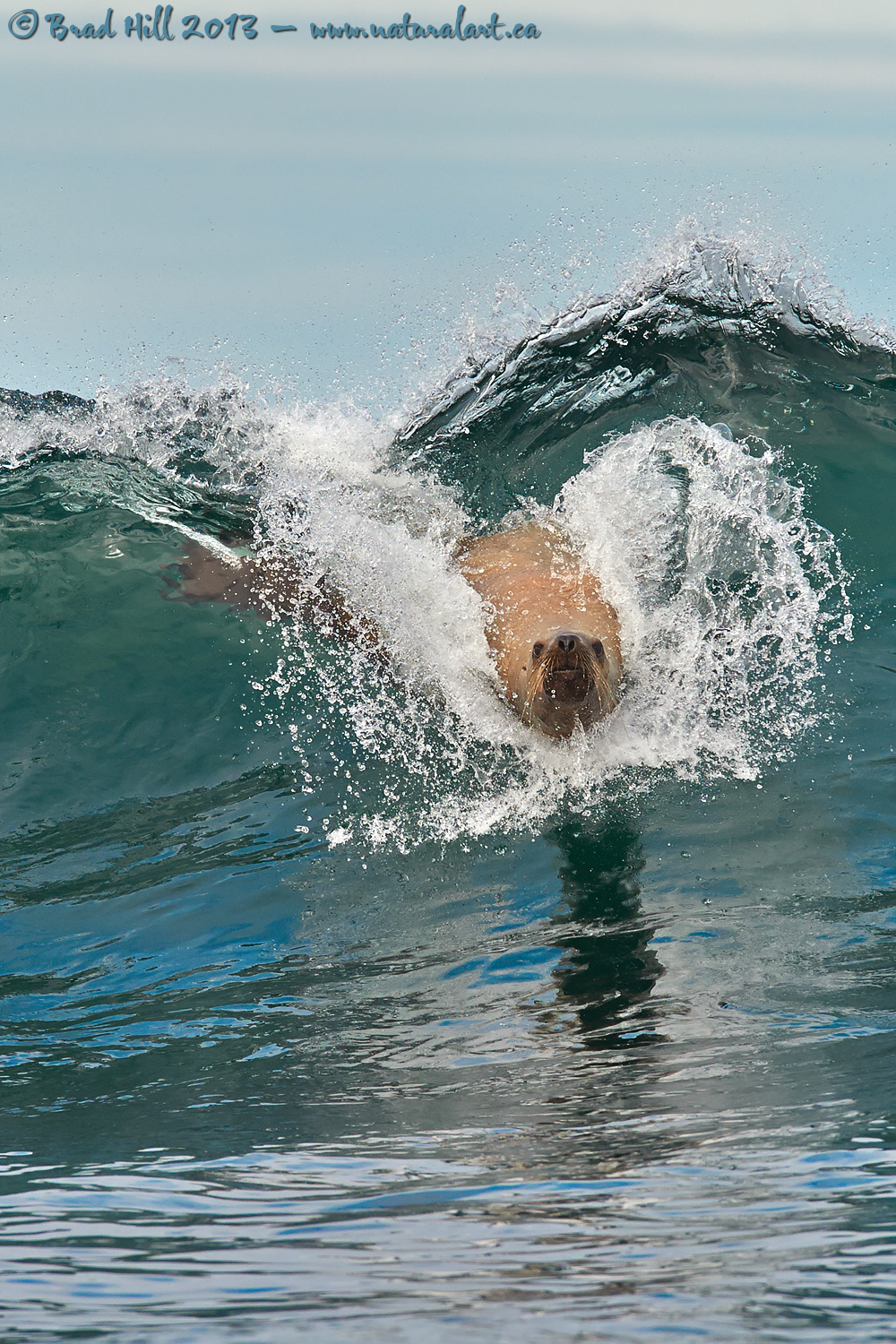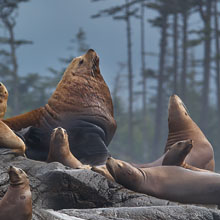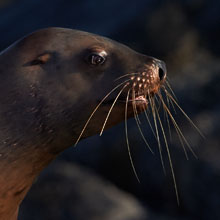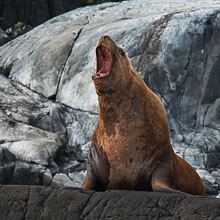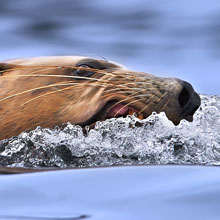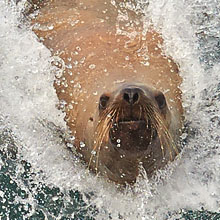Availability: Undetermined - Enquiries?
In the Field
Catching the Wave - Surfin' Sea Lion. Northern Vancouver Island region, BC, Canada. August 21, 2013.
The 2013 version of my annual "Humpbacks, Orcas, Sea Lions and More" photo tour delivered up a lot of memorable moments and events - we had great humpback whale viewing and photography, some very cooperative and always-so-cute sea otters, amorous gray whales doing amorous things, and more. But - at least for me - the most memorable (and a real "hey, I didn't know they did that") moment was when we stumbled about a troupe of surfing - yes surfing - sea lions.
There's a very remote sea lion colony we regularly visit on this trip. Near the edge of the colony (and further into the open ocean), there's a few rocks where the swells break into very surfable waves. And...to our surprise...a group of about 20 subadult Steller sea lions were surfing in the big breakers. Over and over again. The sea lions would only join the waves breaking away from the rocks and would ride the waves as far the could - often for a good 100 metres - and then turn back and swim out to catch another. We watched the sea lions for about a half an hour and then returned on the following day (when the tide was at about the same height) and found the sea lions there (and surfing) again. Over the time we watched the sea lions we saw single surfers on a wave, some "doubles", and few triples, and even one wave with 4 sea lions rippin' along in parallel. We even saw a few particularly daring lions actually enter - and then disappear - "under" the curl (riding the pipe?) and emerge through the cascading waves. It was an incredibly cool thing to watch (and photograph!).
As a trained behavioural ecologist I tend to think in terms of "adaptive benefits" and "survival values" when observing animal behaviour. And, of course, I always try to avoid anthropomorphism. But it was REALLY hard to watch these frolicking sea lions and think they were doing this for any reason other than having a good ol' time...you know...old fashioned FUN!
This "seeing is believing" image deserves a good look...so...just for your viewing pleasure - here's a 2400 pixel version of it:
• Catching the Wave- Surfin' Sea Lion: Download 2400 pixel image (JPEG: 2.5 MB)
ADDITIONAL NOTES:
1. This image - in all resolutions - is protected by copyright. I'm fine with personal uses of it (including use as desktop backgrounds or screensavers on your own computer), but unauthorized commercial use of the image is prohibited by law. Thanks in advance for respecting my copyright!
2. Like all wildlife photographs on this website, this image was captured following the strict ethical guidelines described in The Wildlife FIRST! Principles of Photographer Conduct. I encourage all wildlife photographers to always put the welfare of their subjects above the value of their photographs.
3. This image was captured during my "Humpback, Orcas, Sea Lions & More" photo tour in August of 2013. Each year I offer trips into two different parts of the Great Bear Rainforest as well as one to photograph aquatic mammals and oceanscapes near the northern tip of Vancouver Island. And, in selected years, I also offer photo tours to locations to capture other highly sought-after subjects, such as various owl species of the boreal forest and wildlife of Canada's Arctic. Details about these trips can be found on the Photo Tours page of this website.
Behind the Camera
Catching the Wave - Surfin' Sea Lion. Northern Vancouver Island region, BC, Canada. August 21, 2013.
Digital Capture; Compressed RAW (NEF) 14-bit format; ISO 720.
Nikon D4 paired with Nikkor 400mm f2.8 VR lens. Hand-held from floating Zodiac. VR on and in normal mode.
1/2500s @ f6.3; -0.33 stop compensation from matrix-metered exposure setting.
At the Computer
Catching the Wave - Surfin' Sea Lion. Northern Vancouver Island region, BC, Canada. August 21, 2013.
RAW Conversion to 16-bit TIFF, including first-pass/capture sharpening using Capture One Pro version 7. Three raw variants (different versions of a single raw capture) differing by a total of 1 stop in total exposure (and with further differences in saturation and highlight retrieval settings).
Further digital corrections on resulting 16-bit TIFF files using Adobe's Photoshop CC and Light Craft's LightZone. Photoshop adjustments included compositing/blending of the three exposure variants, very minor colour tweaks (hue rotation and desaturation of selected colours), and selective sharpening for web output. Final tone tweaking performed using tonemapper/re-light tool in LightZone.
Conservation
Catching the Wave - Surfin' Sea Lion. Northern Vancouver Island region, BC, Canada. August 21, 2013.
Ten percent of the revenue generated by this image will be donated to Raincoast*.
Species Status in Canada**: Special Concern (November 2003) - protected in Canada since 1970.
The Steller Sea Lion (Eumetopias jubatus) is the largest of the sea-lions, and males can weigh up to a ton (females are considerably smaller and rarely weigh over 600 lb). Males compete among themselves for females, and successful males end up breeding with several females within their harem.
From the early 1900's through to the 1970's huge numbers of Steller's Sea-Lions were culled for their fur and to remove a competitor (for humans) for salmon. During that time approximately 55,000 sea lions were killed and the breeding population of BC was lowered to about 4,000 animals. Since the Steller Sea Lion first received protection in 1970 the population in the coastal waters of BC has grown to between 18,000 to 19,700 animals (7,600 or so of these are of breeding age).
*The Raincoast Conservation Society (and Foundation) is an effective and efficient organization that has been fighting for protection of this unique habitat. If you are looking for a meaningful way to contribute to the conservation of this amazing ecosystem, Raincoast will provide maximal "bang" for your conservation dollars.
**as determined by COSEWIC: The Committee on the Status of Endangered Wildlife in Canada












